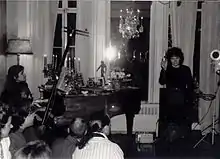Natasha Theremin | |
|---|---|
 | |
| Background information | |
| Birth name | Natasha Theremin |
| Born | 24 June 1948 Russia |
| Genres | Classical music, electronic music |
| Occupation(s) | Musician |
| Instrument(s) | Theremin |
Natalia Lvovna Termen (Russian: Наталья Львовна Термен; born 24 June 1948), better known as Natasha Theremin, is a Russian musician.
Early life
She is the daughter of Russian scientist, musician and inventor Léon Theremin and Maria Feodorovna Theremin (Gushchina). Her father invented the instrument in which she specialized, the theremin in 1919.
Theremin received her first music lessons as a child from her father, who accompanied her on the piano. She graduated from the School of the Moscow Conservatory and the Gnessin Academy with a specialty in teaching piano.
Career
Beginning in the late 1970s, she began to develop new techniques on how to play the theremin, and became one of the few prominent concert performers on this instrument at the time.
Natasha Theremin introduced the instrument configuration that uses the edge of the palm. One octave fits between the open and closed positions of the hand. These settings were favored by performers such as Carolina Eyck, Masami Takeuchi and Lydia Kavina.
Continuing the innovations of Lev Theremin, Natasha created new interpretations of classical works, including "Swan" by Saint-Saens, "Daisies" and "Vocalise" by Sergei Rachmaninoff and "Concerto for voice" by Glier. She performs contemporary music for the theremin, written especially for her (such as "Fantasia for theremin and organ" by S. Archer, "Melody for theremin" by Vorontsov). She gives concerts in Moscow, Leningrad, Kazan, Vilnius, Tallinn and is involved in the filming of documentaries.
During joint visits with her father, Natasha Theremin demonstrated the theremin at the festival in Bourges, (France)[1] and the concert program of the International Computer Music Festival in Stockholm (Sweden, 1990), New York University, the University of Berkeley (US, 1991) and during the award to Leo Theremin in the "Academy of light" in The Hague (Holland, 1993).[2]
On September 25, 1991, at Stanford University, a concert was held in honor of Lev Theremin, in which Natasha, accompanied by electronic music pioneer Max Mathews,[3] performed Rachmaninoff's "Vocalise".[4][5]
Léon Theremin created a series of concerts for the tube theremin especially for Natasha. Under her guidance, Russia attempted to create the world's first theremin concert on a modern technology base. The tool was presented at festivals in France, Lithuania and Sweden.
After her father's death, Natasha stopped concerts. She resumed public activity in 2013, performing at the Festival Theremin in the Central Museum of Musical Culture in Moscow.
In 2016 and 2019 she toured Hamamatsu, Tokyo and Kyoto.
Natalia was the co-organizer of the international festival of theremin culture, Thereminology, and curator of the Russian Theremin School (the only theremin school in Europe and Russia).
See also
References
- ↑ Montague, Stephen (1 January 1991). "Rediscovering Leon Theremin". Tempo (177): 18–23. doi:10.1017/S0040298200013528. JSTOR 945928. S2CID 145282929.
- ↑ Chadabe, Joel (1 January 1997). "Electric Sound: The Past and Promise of Electronic Music". Prentice Hall – via Google Books.
- ↑ Institut national de l'audiovisuel (France) (1 January 2008). Max Mathews. Stanford University Center for Computer Research in Music and Acoustics. ISBN 9782869382060 – via Google Books.
- ↑ "Soviet pioneer of electronic music pays historic visit to Stanford".
- ↑ Cunningham, Robert (1 January 2001). Sergei Rachmaninoff: A Bio-bibliography. Greenwood Publishing Group. ISBN 9780313309076 – via Google Books.